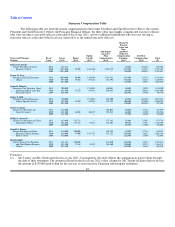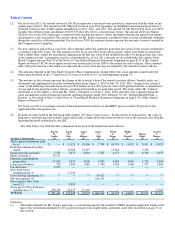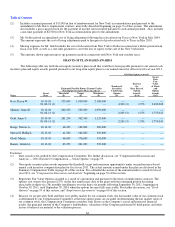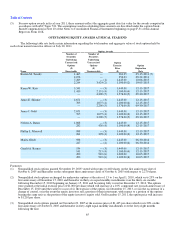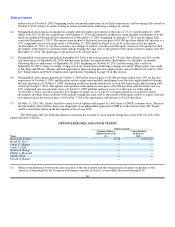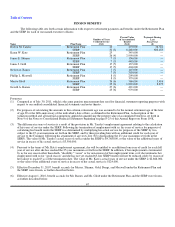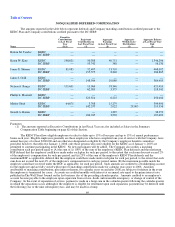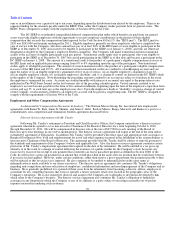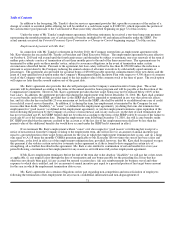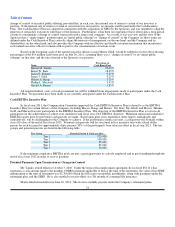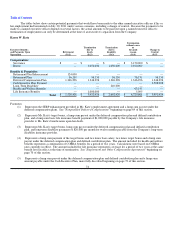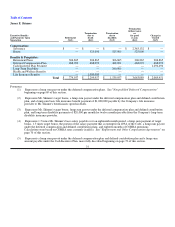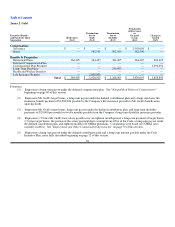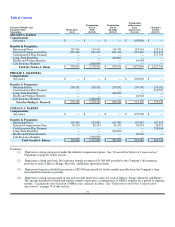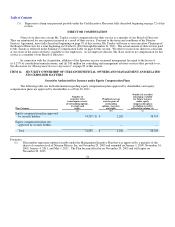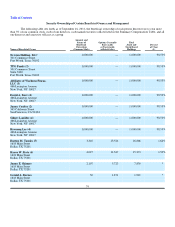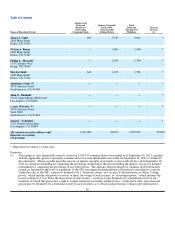Neiman Marcus 2010 Annual Report Download - page 76
Download and view the complete annual report
Please find page 76 of the 2010 Neiman Marcus annual report below. You can navigate through the pages in the report by either clicking on the pages listed below, or by using the keyword search tool below to find specific information within the annual report.
Table of Contents
sum or in installments over a period of up to ten years, depending upon the distribution form elected by the employee. There is no
separate funding for the amounts payable under the KEDC Plan, rather the Company makes payment from its general assets. The
KEDC Plan is designed to comply with the requirements of Section 409A of the Code.
The DC SERP is an unfunded, nonqualified deferred compensation plan under which benefits are paid from our general
assets to provide eligible employees with the opportunity to receive employer contributions on the portion of their eligible
compensation that exceeds the compensation limit imposed by the Code Section 401(a)(17) (the "IRS Limit"). The IRS Limit for
2010 was $245,000 and remains unchanged for 2011. Eligible employees generally are those employees who have completed one
year of service with the Company, who have annual base pay of at least 80% of the IRS Limit (or were eligible to participate in the
SERP as of December 31, 2007 and ceased to be eligible to participate in the SERP as of January 1, 2008), and who are otherwise
designated as eligible by the Company's employee benefits committee. The Company will make transitional and non-transitional
credits to the accounts of eligible participants each pay period. Transitional credits apply only to participants who were eligible to
participate in the SERP as of December 31, 2007 but ceased participating in the SERP as of that date and became a participant in the
DC SERP on January 1, 2008. The amount of a transitional credit is the product of a participant's eligible compensation in excess of
the IRS Limit and an applicable percentage ranging from 0% to 6% depending upon the age of the participant. Non-transitional
credits apply to all eligible participants. The amount of a non-transitional credit is the product of a participant's eligible compensation
in excess of the IRS Limit and 10.5%. All transitional and non-transitional credits are credited to a bookkeeping account and vest
upon the earlier of (i) an eligible employee's attainment of five years of service, (ii) an eligible employee's attainment of age 65,
(iii) an eligible employee's death, (iv) an eligible employee's disability, and (v) a change of control (as defined in the DC SERP) while
in the employ of the Company. Notwithstanding the preceding, amounts credited to an account are subject to forfeiture in the event
the employee is terminated for cause. Accounts are credited monthly with interest at an annual rate equal to the prime interest rate
published in The Wall Street Journal on the last business day of the preceding calendar quarter. Vested amounts credited to an
employee's account become payable in the form of five annual installments beginning upon the later of the employee's separation from
service and age 55, or such later age as the employee may elect. Upon the employee's death or "disability" or upon a change of control
of the Company, vested amounts credited to an employee's account will be paid in a single lump sum. The DC SERP is designed to
comply with the requirements of Section 409A of the Code.
Employment and Other Compensation Agreements
As discussed in "Compensation Discussion & Analysis," The Neiman Marcus Group, Inc. has entered into employment
agreements with Karen W. Katz, James E. Skinner, and James J. Gold. Each of Messrs. Bangs, Maxwell, and Barnes is a party to a
confidentiality, non-competition and termination benefits agreement, discussed below.
Director Services Agreement with Mr. Tansky
Following Mr. Tansky's retirement as President and Chief Executive Officer, the Company entered into a director services
agreement wherein he agreed to act as non-executive Chairman of the Board of Directors for a term beginning October 6, 2010
through December 31, 2011. He will be compensated in this new role at the rate of $37,500 for each meeting of the Board of
Directors up to four meetings in any twelve-month period. The director services agreement will expire at the end of the term unless
extended by agreement of both parties. In addition, Mr. Tansky will be provided with office space and appropriate staff assistance at
Bergdorf Goodman in New York and reimbursement for travel and other expenses incurred in the fulfillment of his responsibilities as
non-executive Chairman of the Board of Directors. The agreement provides that Mr. Tansky shall be subject to removal pursuant to
the standards and requirements of the Company's bylaws and applicable law. Also, the director services agreement continues certain
provisions of Mr. Tansky's employment agreement that expired on the date of his retirement. He will be entitled to a tax gross-up
whereby if, in the event of a change of control following the existence of a public market for the Company's stock, he incurs any
excise tax by reason of his receipt of any payment that constitutes an excess parachute payment as defined in Section 280G of the
Code, he will receive a gross-up payment in an amount that would place him in the same after-tax position that he would have been in
if no excise tax had applied. However, under certain conditions, rather than receive a gross-up payment, the payments payable to him
will be reduced so that no excise tax is imposed. He also continues to be entitled to indemnification on the same terms as
indemnification is made available to our senior executives. The director services agreement also continues Mr. Tansky's obligations
regarding non-competition and non-solicitation of employees, confidential information and non-disparagement of the Company and its
business. He is generally prohibited, for a period of three years from his retirement, from becoming a director, officer, employee or
consultant for any competing business that owns or operates a luxury specialty retail store located in the geographic areas of the
Company's operations. He is also required to disclose and assign to the Company any trademarks or inventions developed by him
which relate to the Company's business. The director services agreement also continues Mr. Tansky's obligation to furnish his
assistance in any litigation in which the Company or any of its affiliates is a party subject to receiving reasonable out-of-pocket
expenses incurred in rendering such assistance.
70


